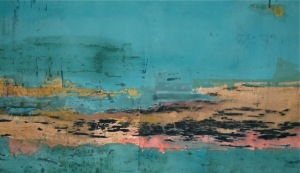by Robin Sierra | Uncategorized |
In 2009….I lost everything dear to me; my husband, home, art, dog, books, furniture etc. I abruptly found myself unmoored, untethered and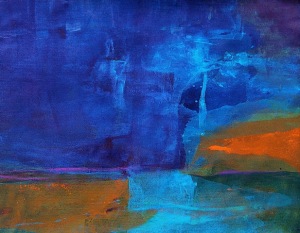 navigating in the dark.
navigating in the dark.
How I wished I had equivalent skills to the Polynesian navigators who memorize important facts: the motion of specific stars, where they would rise and set on the horizon of the ocean; weather and the seasons of travel; wildlife species (which gather at particular positions); the direction, size and, speed of ocean waves; colors of the sea and sky, especially how clouds would cluster at the locations of some islands; and angles for approaching harbors. *
Was it premonitory that just before everything fell apart I had written on my Facebook page: “Robin is now entering the Realm of the Starry Night.”
I have been painting in an improvisational manner for many years. I do not have a concept in mind when I begin a piece. From the time I thrum the courage to put down the first mark on canvas the painting becomes an improvised dance. A pas de deux between my inner and outer selves. Between spontaneity and painterly knowledge, between logic and risk, dark and light, wrangling and grace.
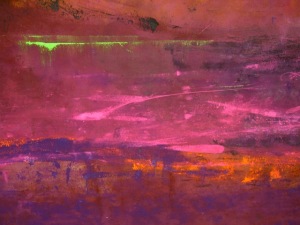 And, now when everything was rawly unfamiliar, unpredictable, no home, no income, living with wrenching grief, I was forced to not just make art in the studio but to see my life as art, applying the same principles. the willingness to continually leap across abyss after abyss, to not know where I would be from week to week, day to day, hour to hour, sometimes even moment to moment. I had to hone the improvisational skills of knowing when to stay or when run, whether to boldly leap or take tentative steps. When to hang on tight or release. When to pull out my six-shooters or to quietly back away.
And, now when everything was rawly unfamiliar, unpredictable, no home, no income, living with wrenching grief, I was forced to not just make art in the studio but to see my life as art, applying the same principles. the willingness to continually leap across abyss after abyss, to not know where I would be from week to week, day to day, hour to hour, sometimes even moment to moment. I had to hone the improvisational skills of knowing when to stay or when run, whether to boldly leap or take tentative steps. When to hang on tight or release. When to pull out my six-shooters or to quietly back away.
I believe that although I have been kicking and screaming most of the way, that my deeper self, my Soul Self, knew all along what I truly needed to come ‘Home’ and has been putting me through the proverbial wringer, to squeeze out whatever is not authentic. Whatever is delusional. The sand on which I built my life.
A friend told me she saw me as being chiseled, like a marble sculpture and with each sharp and painful blow, the whatever was not me was being cut away to eventually reveal my hidden beauty.
When I began painting again last winter it was like coming home. Art has always and continues to be my salvation, my medicine. It is my reflecting pool that mirrors what is true for me in the moment and it cannot be fooled.
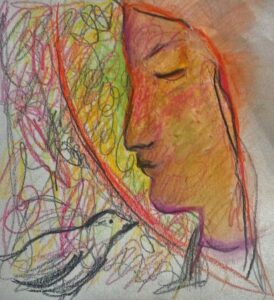 Words and Paintings by Robin Sierra
Words and Paintings by Robin Sierra
*from Wikipedia
by Robin Sierra | Art, Creativity, grief and loss |
by Robin Sierra
Published in Western North Carolina Woman
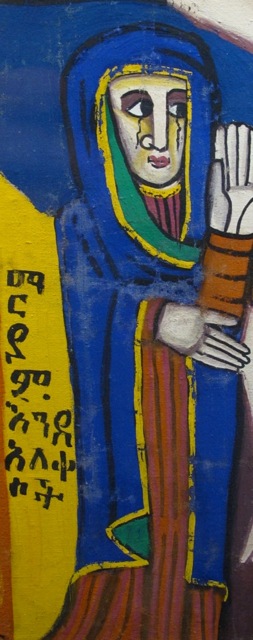 After being married for ten years, my friend Summer realized she had lost herself somewhere along the way. Without noticing, a voice inside her she calls the the “Antique Woman” had begun dominating her thoughts.
After being married for ten years, my friend Summer realized she had lost herself somewhere along the way. Without noticing, a voice inside her she calls the the “Antique Woman” had begun dominating her thoughts.
Summer’s Antique Woman doesn’t believe in her own autonomy or power. She clings to a fantasy of how relationships should or could be rather than coming to terms with how they really are. She keeps the truth hidden, even from herself. She clutches to relatedness when the relationship is no longer working and gives herself away in order to keep a marriage intact. Summer loved being a part of a family and being a mother, but she consistently put her husband’s needs before her own, and denied her instincts which, in the form of intuitions and dreams of her husband’s infidelity, told her that her marriage was in trouble.
Nonetheless, she ignored these signs, She was not willing or ready to face what it would mean to let go of her marriage—becoming a single parent, sleeping alone, the pain of separation, loneliness, letting go of the idea of family, feeling like a failure. The consequence of suppressing these instincts was that she doubted her instincts in general. She began to wonder, “Where have I gone? Where am I?”
It was the artist in her that led her back to remembering who she was.
Throughout her life Summer felt like an artist without an art-form. She would often reach into the air, wriggling her fingers, kneading the sky, trying to fulfill an unknown longing. In her twenties, her “vagabond days”, she baked bread. She loved plunging her hands into the soft, warm dough. She loved the sensuality of kneading and punching, of working the muscles in her arms and back. But years later, in the midst of the disquiet of her relationship, a neighbor offered a clay class. When she put her hands in the mud of the earth, Summer knew she had found what she was yearning for. Soon after she started making sculptures, she felt a sense of familiarity, as if she already knew how to sculpt. She received positive responses from others right from the beginning, but praise wasn’t important. For the first time in her life, approval and disapproval were irrelevant, because the “making” itself was so fulfilling.
As her work progressed, something unexpected began to emerge. She had done a sculpture from an eighty year old model, a woman with a “kind and wise countenance,” and when the piece was nearly finished Summer brought it home and would move it to different spots around the house. It wasn’t long before she noticed that she had begun talking to the sculpture, sharing her musings and personal dilemmas, and soon the sculpture began speaking to her! This wasn’t delusion. Summer had a playful nature, and as a child she was often accused of having an overactive imagination. She knew it was her own voice projected out to the clay figure, a lost part of herself that needed to be heard.

Crone: Sculpture by Summer
As Summer continued this unusual dialogue, the old woman told her to keep working on her, and gave her specific instructions. She was now directed to carefully scrape off the old woman’s hair, to hollow out the inside of her head, to slice off the neck, and finally to lay the head face-up in a sculpted bowl. When Summer was finished, the figure had been transformed. She was now bald, and because the head was hollow there was a darkness and depth through the portals of her eyes. Instead of a kindly, older woman, she was now a powerful crone. Summer was witnessing a part of herself becoming visible. Her husband was so disturbed by the sculpture that he asked Summer to throw a cloth over the head, but women friends who came by to visit were intrigued and strengthened by her.
The same thing continued with every sculpture she made from then on. They all “spoke” to her. Summer was now committed to following wherever each sculpture would lead, no matter how unreasonable it seemed. If she ruined it in the process, so be it. She stopped asking other people for their opinions, and began to trust her own instincts once again. If she heard one of the sculptures speaking to her, she wouldn’t question whether the directive was right or wrong, only whether it felt right, she would follow it. If the figure beckoned her to cut off its arms, she did. If it asked her to place a crown embellished with suns and moons, birds and snakes on its head, she did. If it asked her to lop off its feet, even when she had spent days painstakingly crafting each toe, she did. If a male figure told her to carve a hidden womb in his belly, she did. It was an adventurous experiment and as she proceeded, she found that the directives were invariably “right”. Each sculpture revealed a forgotten part of herself. She began to refer to this creative impulse as her “Do This Now Voice.”
By listening to her “Do This Now Voice,” Summer gradually began to realize that she could no longer hold on to her illusions about her marriage. As the truth of her husband’s infidelity emerged and their marriage began to unravel, with it came tremendous pain and chaos. Summer felt directionless, jangled and close to madness. The dreams of her life seemed shattered.
What was previously masked by the strained and smiling face of the Antique Woman, by her desperation to keep things together, was now revealed. What had been buried was exhumed. Summer was willing to work with whatever emotions came up. She had been lost for too long and she knew that if she sincerely wanted to come all the way home, she had to be willing to experience the pain of what she had denied.
Summer was called into the underworld, and she followed.
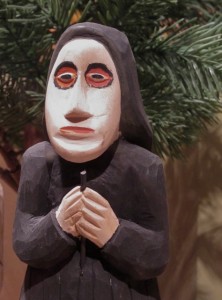
Composting Grief: Sculpture Santa Fe FolkMuseum
For two years after she and her husband separated, Summer wore black clothes. She didn’t mask her anguish and restlessness by watching television, reading mystery novels or schmoozing at the local cafe. She fought against a powerful urge to keep herself busy when she felt sad or depressed. Trying to fix what appeared to be broken, to “lighten up” and “get over it” wouldn’t work. She had to live through the unremembered wounds of a lifetime that were triggered by the (eventual) divorce. What has been restrained cried out to be seen and heard.
Summer called this her “composting” period. Compost is garbage: wilted cabbage and flowers, squashed plums, moldy bread, tea bags, dead leaves and dirt, all piled together and decaying. Eventually, with time, moisture, air, and worms, this mound of cast off stuff transforms into a rich nurturing substance. “I was an accidental seed that was buried in the compost and it was only a matter of time before I was going to sprout. I knew that eventually something would grow, but that it would take time. I trusted myself enough now to know what I needed to do, regardless of what anyone else thought.” And what she most needed to do was not to do anything, to lie fallow, to feel what she felt.
We must be willing to compost our grief, loss and powerlessness. Slyvia Perera, author of Descent to the Goddess, says that there are times when we are “suspended out of life.” There is no rushing this process. It must happen in its own timing. We don’t know where such experiences will take us, or how long they will last, but some part of us knows that we must go down deeply before we can come up again. We feel compelled to demolish the illusions of who we thought we were, to let the obsolete vision die, so that a more honest one can arise. If we have the intention, courage and stamina, the heat of the compost will eventually burn out what is false.
Summer allowed herself to compost for several years, despite the fear that she would dive so deeply that she would never resurface. Instead, she found in herself a strength and fierceness she didn’t know she possessed, as well as the ability to bear the unbearable. She no longer had to strain to keep hidden the parts of herself that she feared. She was no longer afraid of uncovering the truth, feeling her pain, and speaking her mind. A sense of deep relief welled up in her, and she knew that the errant seed had taken root.
Summer’s home is now bursting with clay figures that she is in continual dialogue with, that teach and empower her. This is her unearthed chorus of voices, parts of herself made visible, parts that make up the whole of who she is. Among them is the Crone who speaks to her of the deepest truths, the Hermit who shows her the secrets of the cave, and the Hag who emboldens her to be funny and bawdy. There is even a place for the Antique Woman.
by Robin Sierra | Uncategorized |
Art and Words by Robin Sierra
The family couch in the house where I grew up had cushions that were squashed flat by the weight of my father’s despair He lay down for days that turned into years. There were times when I would peer into his darkened bedroom, terrified that he might not be breathing. Once, in my desperation, I went into his room, grabbed his arm and tried to pull him out of bed. In addition to leaving a lasting indentation on the couch, his experience left a huge dent in my psyche. Through his depression, I learned that when life gets difficult, the only response is to give up and lie down and withdraw from those around you.

And although I was blessed that my mother loved me even before I was born, she also struggled with being overwhelmed by life. I have a memory of myself around 5 or 6 years old of my parents getting ready to leave the house and me running out to the car curling in a ball, trying to hide in the back seat. They had to drag me out of the car while I was sobbing, feeling a deep desperation. I had no words or understanding, only raw emotional panic.
It was only many years later I found out that at that time my mother was suicidal. She was seeing a psychiatrist in the 50’s, which was quite unusual back then, so obviously, she was teetering on an edge. She had migraine headaches everyday I can remember and life in general caring for my sister and I was just too much for her.
Before all of this entered my life I was basically a very happy, creative little girl. I got straight A’s and loved to be in front of the class leading the kids in song on my Autoharp and was always the teacher’s favorite. But when my father plummeted into severe depression, something deep shifted in me. My mental capacities diminished and my grades went way down and I couldn’t concentrate because I was full to the brim with psychological pain that was not being acknowledged in any way. I was skinny, skinny and unable to gain weight because there was a constant knot in my stomach and I continued to suck my thumb into my teen years. In other words, I was a wreck. I had incorporated the densely dark and anxiety-laden feeling in my home and took it on as my identity.
Turning Point
My first experience in realizing that I may be an artist was when I screwed up the courage to take a figure drawing course in my first year of college. I drew with one arm circling around the drawing so no one could see what I was doing because I took for granted that it would be awful. But when there was a break, I walked around the room and by looking at the other student’s drawings; I was astonished to recognize that I was making a beautifully executed drawing.
When I finally made the decision to leave home at 21, I was completely unprepared to deal with the world. I didn’t even know how to do my laundry or write a check. When you grow up with mentally ill parents they are so saturated in their own suffering that they cannot ‘see’ their children clearly. They believed, only because they needed to, that we were two happy little girls. They had no idea that I was being so deeply impacted by their anguish. And, because they were so flooded with their own pain they neglected to teach me the basics of how to function in life.
I left Los Angeles, which I was chomping at the bit to escape from, and went to the top of California, near the Oregon border to Humboldt County. (Yes, we all know what Humboldt is famous for) I felt like I had ‘come home’. Being a person for who nature was imperative, L.A. was not a match for me. There I began an inner journey of meditation and coming to terms with my childhood.
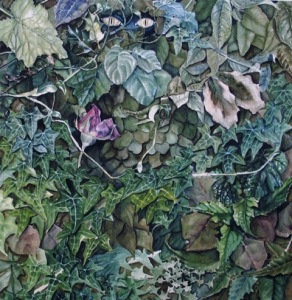
One day, I decided to peruse the University campus in Arcata. I walked into the art building and when I saw the art on the walls in the hallways, I again was astonished in seeing and knowing that I would be good at making art. So, I immediately enrolled in college as an art major. Here is one of the first watercolors I made. I had no idea what I was doing. Actually started from the left top corner and worked my way diagonally across the page with no planning ahead.
Gratitude
My gratitude for the gift, the talent I was given is tremendous because my head was still so clouded and overloaded with unresolved emotions that I couldn’t think clearly. But art was a different story. I had a razor sharp focus when I was making art and, I had something in my life I could actually ‘see’ that I was good at. This may have been the biggest turning point in my life because I can’t imagine what would have become of me if I had not made what I now call my ‘choiceless choice’ to be an artist. I truly believe art saved my life.
I was 22 at the time and now many decades later, although I spent years clearing the emotional trauma I inherited, and have a mind that works very well which I am grateful for beyond words. I am still making art and it is still saving me.
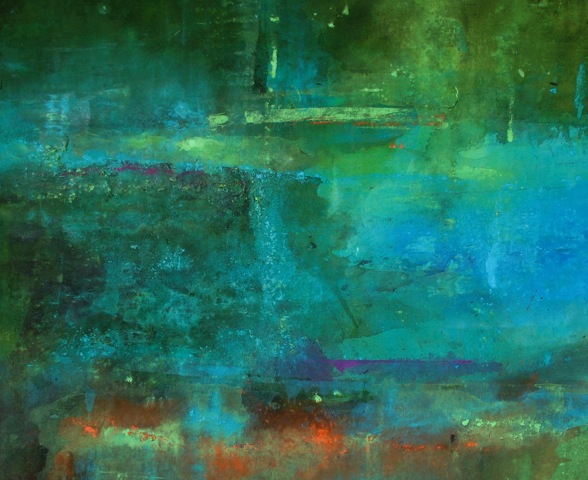
by Robin Sierra | Creativity |
by Robin Sierra
Published in Science of Mind Magazine
Paintings by Jeanie Tomaneck, sketch by Robin Sierra
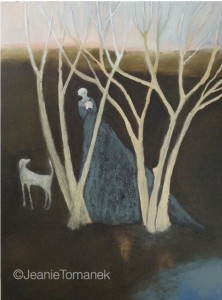 My first glimpse of the volcano was from out at sea, orange glowing against the black night sky, the shore of the ocean on fire. The following day I went to where Kilauea met the ocean. Fire spilled into water, together hissing and churning while white clouds of steam boiled into the air.
My first glimpse of the volcano was from out at sea, orange glowing against the black night sky, the shore of the ocean on fire. The following day I went to where Kilauea met the ocean. Fire spilled into water, together hissing and churning while white clouds of steam boiled into the air.
Kilauea is a volcano on the island of Hawaii that has been steadily erupting for the past thirteen years. The lava moves so slowly that I was able to stand right at its leading edge, as close as the intense heat would allow. This creeping pace is deceptive. Nothing stands in its way, not stop signs, not trees, not whole towns. During one siege when the lava was threatening to destroy homes, the U.S. Army tried to divert it, with dubious success, by dropping 600 pound bombs in its path. Diversion is the best they can do. Nothing stops the lava from reaching its destination.
I was impressed. I wanted to be like that, unstoppable. (more…)
 navigating in the dark.
navigating in the dark. And, now when everything was rawly unfamiliar, unpredictable, no home, no income, living with wrenching grief, I was forced to not just make art in the studio but to see my life as art, applying the same principles. the willingness to continually leap across abyss after abyss, to not know where I would be from week to week, day to day, hour to hour, sometimes even moment to moment. I had to hone the improvisational skills of knowing when to stay or when run, whether to boldly leap or take tentative steps. When to hang on tight or release. When to pull out my six-shooters or to quietly back away.
And, now when everything was rawly unfamiliar, unpredictable, no home, no income, living with wrenching grief, I was forced to not just make art in the studio but to see my life as art, applying the same principles. the willingness to continually leap across abyss after abyss, to not know where I would be from week to week, day to day, hour to hour, sometimes even moment to moment. I had to hone the improvisational skills of knowing when to stay or when run, whether to boldly leap or take tentative steps. When to hang on tight or release. When to pull out my six-shooters or to quietly back away. Words and Paintings by Robin Sierra
Words and Paintings by Robin Sierra





